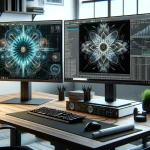Advancements in telescope mirror technology could pave the way for more cost-effective and versatile space observations. Researchers are exploring alternatives to traditional glass mirrors, aiming to overcome manufacturing and structural challenges. The introduction of ferrofluids in telescope design may offer new possibilities for astronomical research.
How Do Liquid Mirror Telescopes Work?
Liquid mirror telescopes utilize a spinning liquid, traditionally mercury, to form a parabolic reflective surface. By rotating the mercury slowly, the liquid naturally assumes the desired shape, enabling the capture of light from celestial objects. This method significantly reduces costs; for instance, the 6-meter Large Zenith Telescope (LZT) achieved similar capabilities at a fraction of the expense of conventional mirrors.
What Challenges Limit Liquid Mirror Telescopes?
The primary issues with liquid mirror telescopes involve the toxicity of mercury and their inability to track celestial objects across the sky. Mercury’s hazardous nature poses environmental and safety risks, while the fixed upward observation limit restricts the telescope’s functionality. These drawbacks have hindered the widespread adoption of liquid mirror technology in astronomy.
Can Ferrofluids Address These Limitations?
A recent study published in Acta Astronautica suggests that ferrofluids could replace mercury in liquid mirror telescopes. By integrating electromagnets, the ferrofluid mirrors could maintain a parabolic shape through magnetic currents, allowing for some degree of orientation adjustment. This innovation holds promise, particularly for space-based telescopes where lower gravity environments enhance the effectiveness of magnetic shaping.
Research compares current ferrofluid mirror designs to traditional segmented mirrors, highlighting potential cost reductions and structural benefits. Unlike segmented mirrors that require complex alignment, ferrofluid mirrors offer a simpler construction process. However, practical implementation remains challenging due to the precision needed in electromagnet control, a hurdle not yet overcome by existing electric circuitry standards.
“The integration of ferrofluids with electromagnetic control could revolutionize how we approach telescope design in space,”
a lead researcher stated, emphasizing the potential for significant advancements in astronomical observation capabilities.
Future developments in electric circuitry precision are essential for realizing ferrofluid mirror telescopes. As technology progresses, overcoming current limitations may enable the deployment of these innovative mirrors on the Moon or in orbit, offering more flexible and affordable options for capturing the universe’s mysteries.










